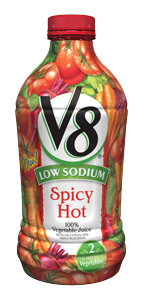
|
Sodium consumption has been a large concern in the food industry because, in excess, it can lead to high blood pressure, which can increase the risk for heart attacks, strokes, heart failure and kidney failure, according to the U.S. Food & Drug Administration (FDA). Now consider that according to Russell Keast, associate professor at the Center for Physical Activity and Nutrition at Deakin University in Australia, the average American consumes nearly four times the recommended amount.
The human body needs 2.5 grams of sodium each day; however, Americans consume about 9.5 grams, coming primarily from processed and restaurant foods, Keast said in an Institute of Food Technologists press release.
According to the American Heart Association (AHA), as much as 75 percent of the sodium that Americans consume is found in processed foods such as tomato sauce, soups, condiments, canned foods and prepared mixes. On average, two slices of processed ham contain 730 mg. of sodium, while 1 cup of ready-to-serve chicken noodle soup has 840 mg. of sodium, reports the U.S. Department of Agriculture (USDA) National Nutrient Database for Standard Reference. But where do beverages fit in?
When comparing multiple beverage categories, dairy and vegetable juice product categories are among the highest in sodium. According to pepsiproductfacts.com, a 12-ounce can of soda typically contains between 30 mg. and 70 mg. of sodium. One cup of 2 percent milk, on the other hand, contains 145 mg. of sodium, and 1 cup of tomato juice contains 883 mg. of sodium, the website notes, citing the AHA and USDA National Nutrient Database for Standard Reference.
To offer healthier options, vegetable juice brands, such as V8 and Mott’s, have launched low-sodium varieties. Last month, Dr Pepper Snapple Group launched Mott’s Garden Blend Low Sodium vegetable juice at the same time as a regular variety. And last year the Campbell Soup Co., Camden, N.J., launched V8 Spicy Hot Low Sodium 100 percent Vegetable Juice, with 140 mg. of sodium in each 8-ounce glass, which meets the FDA’s definitions of a low-sodium food, according to Campbell Soup Co.
But when you take vegetable juice out of the equation, there is not a large demand for low-sodium products in the beverage industry — partly because most beverages are fairly low in sodium, and also because beverages aren’t top-of-mind for consumers when it comes to sodium, says Krista Faron, director of innovation and insights at Mintel International, Chicago.
“The issue with sodium is that many consumers simply don’t understand where sodium in their diet comes from,” Faron explains. “I think that’s especially true of beverages: that many Americans don’t understand that beverages can contribute to their sodium intake, so they’re not necessarily monitoring sodium levels because they simply don’t perceive it to be a problem.”
Older Americans, however, take a special interest in low-sodium products, she says. As Americans age, they become more concerned with sodium and might actively seek out low-sodium products, Faron adds. But even if consumers aren’t searching for that low-sodium claim on the packaging, some manufacturers have made a healthful effort to lower the sodium in their products.
In the last four years, the Campbell Soup Co. reduced the sodium in its original V8 100 percent Vegetable Juice twice; it now contains 420 mg. of sodium per 8-ounce glass. In 2009, the company reduced the sodium in its original Spicy Hot V8 juice by more than 40 percent to 480 mg. of sodium per serving.
“Consumers may not be looking for low-sodium claims on beverages and they may not be actively reading the ingredient label, but brands know that it makes sense to take down that sodium if they can, and if consumers don’t notice the difference, then everybody wins,” Faron says.
Low salt solutions
But reducing sodium without compromising taste is the tricky part. Salt is an important ingredient in beverages because of its ability to enhance flavor, dull bitter tastes and act as a preservative to inhibit microbial growth and lower water activity in foods and beverages, says Janice Johnson, applications and technical service leader at Cargill Inc., Minneapolis.
It also plays a vital role in carrying nutrients to cells in the human body, according to pepsiproductfacts.com. The site says, “Sodium is necessary for regulation of blood and body fluids, transmission of nerve impulses, heart activity and certain metabolic functions.”
Despite its advantages, too much sodium can be harmful to one’s health, leading many food and beverage manufacturers to lower the amount of sodium in their products. Considering the important functions of sodium, beverage-makers also are seeking ways to lower sodium without altering a product’s taste.
Salt Answer, a product of Ajinomoto Food Ingredients LLC, Chicago, makes this possible by fooling the tongue into perceiving higher levels of sodium than actually are present in the system, says Joseph A. Formanek, associate director of business development and application innovation at Ajinomoto Food Ingredients.
“Sodium comes from many sources,” Formanek explains. “While prepared foods are a major contributor, certain beverages, typically vegetable juices, can also be quite high in sodium. Certainly we have seen a trend to reduce the sodium level in these types of products.”
Minnetonka, Minn.-based Nu-Tek Products LLC, offers potassium chloride-based solutions for sodium reduction. This product contains less than 0.1 percent sodium and can be blended with sodium chloride for reduced sodium foods without a bitter taste, according to Nu-Tek’s website. Potassium chloride also provides an added benefit of potassium fortification. Studies suggest that diets high in potassium might help lower blood pressure, says Dustin Grossbier, director of quality and technology at Nu-Tek Salt.
Cargill offers Premier Potassium Chloride and SaltWise sodium reduction systems that help bring back the salty taste and functional flavor enhancement role that salt plays in beverages, Johnson says. The Premier Potassium Chloride system is suited for products looking to achieve less than 25 percent sodium reduction. At higher reduction levels, a bitter or metallic note may be perceived by some people, Johnson says. On the other hand, SaltWise is ideal for higher sodium reduction levels because it helps mitigate the bitter or metallic notes, she says. It also brings out fruit and vegetable flavors in beverage applications, she adds.
Currently, some meal replacement beverages are making use of KCLean Salt, a product of Wixon Inc., St. Francis, Wis., to reduce sodium, the company says. KCLean Salt is a salt replacer consisting of salt, potassium chloride and natural flavors, offering a 50 percent sodium reduction, says Mariano Gascon, vice president of research and development at Wixon Inc.
“Potassium chloride is the most viable alternative to replace salt because it has a salty taste of its own, but unfortunately, it is bitter as well,” Gascon says. “The key is in the taste modifier’s combination [of natural flavors] that we developed to mask the bitterness of the potassium chloride and enhance its salty taste to make it taste like regular table salt.”
Wild Flavors Inc., Erlanger, Ky., combines potassium chloride with its SaltTrim technology to reduce sodium in food and beverage applications.
“Many beverages are labeled Low Sodium because the formulations inherently contain little sodium,” says Jessica Jones-Dille, senior manager of industry trends and market research at Wild Flavors. “However, we do see a trend toward products such as vegetable juices that may contain higher amounts of sodium to have low-sodium versions.”
“I believe that sodium reduction in beverages is in its infancy,” Nu-Tek’s Grossbier says. “There are definite opportunities for sodium reduction in some product categories. Once this is recognized by consumers, there will be a greater demand for innovation.” BI



